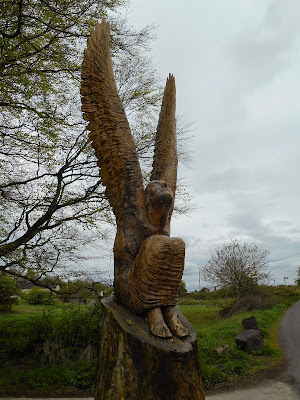Angel Roofs
In the 15th and early 16th centuries several hundred angel roofs were built in England. Of these, more than 140 angel roofs survive. They are almost always found in churches, and over 80% are located in East Anglia, particularly in Norfolk and Suffolk. Bedfordshire, Devon and Denbighshire have a handful between them and Somerset has more than a dozen, depending on how many angels you need for it to count as an angel roof:
- St Cuthbert's Church, Wells
- Selworthy
- Evercreech
- Taunton Minster
- Long Sutton
- Westonzoyland
- Muchelney
- Leigh-on-Mendip
- Cleeve Abbey
- Martock
- Norton St Philip
- Doulting
- St Decuman's Church, Watchet
Angel at Cleeve Abbey
Cleeve Abbey Refectory Roof
This wagon roof was constructed in the 15th century by Abbot David Juyner.
Cleeve Abbey Gatehouse
All Saints' Church, Selworthy
Entrance doors, St Mary Magdalene Church, Taunton
St Mary Magdalene Church, Taunton
St Mary Magdalene Church, Taunton
St Mary Magdalene Church, Taunton
St Giles' Church, Leigh-on-Mendip
St Giles' Church, Leigh-on-Mendip
Leigh-on-Mendip
Church of St Peter and St Paul, Muchelney
This is an unusual roof of painted angels, which were painted in the early 17th century
Mulchelney
Angels behind the altar at Holy Trinity Church, Chantry
St Peter's Church, Evercreech
St Peter's Church, Evercreech
St Peter's Church, Evercreech
St Cuthbert's Church, Wells
St Cuthbert's Church, Wells
St Cuthbert's Church, Wells
St Cuthbert's Church, Wells
St Audries' Church, West Quantoxhead
All Saints' Church, Martock
The angel roof in All Saints' Church was completed in 1513. Sadly I wasn't able to get a good photograph of it, as the church was dark and the roof is very high.
19th century hammer beam trussed roof in the nave of the church of St Peter and St James at Norton St Philip with carved angels
Angel at Norton St Philip
Close to Bristol Airport and at the entrance to a track leading to Felton Common and St Katharine’s Church, there is an angel looking skywards, as if he is about to take flight. He was carved from a dead beech tree by Gloucestershire based artist Ant Beetlestone in 2010.
Felton's Angel
Angel looking skywards
Back of the Felton Angel
Arc of Angels, Portishead Marina
The Arc of Angels, which is located in Central Park, was designed by Rick Kirby and erected in 2002. It represents the new community at Portishead Marina, which gains strength and support from being united. The piece also commemorates the Second World War radio masts, which once stood near the site.
Portishead’s Arc of Angels
Angel in a wall painting at St Mary's Church, Stoke-sub-Hamdon
Angels painted on the east wall of the chancel of St Laurence Church, East Harptree
Etched angels on the door handle of the Minster in Ilminster
Four stained glass angels around St Catherine in the Minster at Ilminster
This window is a memorial to Charles & Elizabeth Bailey and their daughter Mabel Bailey.
It was dedicated in 1964.
Chainsaw carving of an angel in the woods on the National Trust's Tyntesfield estate









































